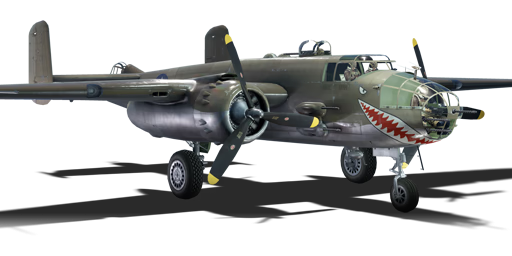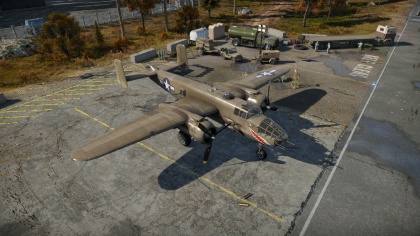B-25J-20
Contents
| This page is about the American bomber B-25J-20. For other versions, see B-25 (Family). |
Description
The B-25J-20 Mitchell is a rank II American bomber
with a battle rating of 4.0 (AB/RB) and 4.3 (SB). It was introduced in Update 1.29.
General info
Flight performance
Describe how the aircraft behaves in the air. Speed, manoeuvrability, acceleration and allowable loads - these are the most important characteristics of the vehicle.
| Characteristics | |||||||
|---|---|---|---|---|---|---|---|
| Stock | |||||||
| Max Speed (km/h at 3,049 m) |
Max altitude (meters) |
Turn time (seconds) |
Rate of climb (meters/second) |
Take-off run (meters) | |||
| AB | RB | AB | RB | AB | RB | ||
| 420 | 407 | 7500 | 32.4 | 33.8 | 5.4 | 5.3 | 750 |
| Upgraded | |||||||
| Max Speed (km/h at 3,049 m) |
Max altitude (meters) |
Turn time (seconds) |
Rate of climb (meters/second) |
Take-off run (meters) | |||
| AB | RB | AB | RB | AB | RB | ||
| 472 | 444 | 7500 | 29.7 | 31.0 | 10.6 | 7.7 | 750 |
Details
| Features | ||||
|---|---|---|---|---|
| Combat flaps | Take-off flaps | Landing flaps | Air brakes | Arrestor gear |
| ✓ | ✓ | ✓ | X | X |
| Limits | ||||
|---|---|---|---|---|
| Wing-break speed (km/h) |
Gear limit (km/h) |
Combat flaps (km/h) |
Max Static G | |
| + | - | |||
| 340 | ~6 | ~2 | ||
| Optimal velocities | |||
|---|---|---|---|
| Ailerons (km/h) |
Rudder (km/h) |
Elevators (km/h) |
Radiator (km/h) |
| < 300 | < 270 | < 350 | > 330 |
| Compressor (RB/SB) | ||
|---|---|---|
| Setting 1 | ||
| Optimal altitude | 100% Engine power | WEP Engine power |
| 524 m | 1,500 hp | 1,669 hp |
| Setting 2 | ||
| Optimal altitude | 100% Engine power | WEP Engine power |
| 3,700 m | 1,350 hp | 1,502 hp |
Survivability and armour
- 10 mm steel - front, sides & rear of the cockpit
- 10 mm steel - the rim of pilot seats
- 8 mm steel - below nose gunner
- 8 mm steel - pilot seats
- 9.5 mm - bulkhead after of dorsal turret
- 6.35 mm steel - aft of waist gunners
- 9.5 mm steel - tail turret
Armaments
Offensive armament
The B-25J-20 is armed with:
- 2 x 12.7 mm Browning M2 machine guns, nose-mounted (400 rpg = 800 total)
- 4 x 12.7 mm Browning M2 machine guns, cheek-mounted (400 rpg = 1,600 total)
Suspended armament
The B-25J-20 can be outfitted with the following ordnance:
- 12 x 100 lb AN-M30A1 bombs (1,200 lb total)
- 4 x 250 lb AN-M57 bombs (1,000 lb total)
- 4 x 250 lb AN-M57 bombs + 8 x 100 lb AN-M30A1 bombs (1,800 lb total)
- 8 x 250 lb AN-M57 bombs (2,000 lb total)
- 2 x 500 lb AN-M64A1 bombs + 8 x 100 lb AN-M30A1 bombs (1,800 lb total)
- 4 x 500 lb AN-M64A1 bombs (2,000 lb total)
- 1 x 1,000 lb AN-M65A1 bomb + 10 x 100 lb AN-M30A1 bombs (2,000 lb total)
- 3 x 1,000 lb AN-M65A1 bombs (3,000 lb total)
Defensive armament
The B-25J-20 is defended by:
- 1 x 12.7 mm Browning M2 machine gun, nose turret (300 rpg)
- 2 x 12.7 mm Browning M2 machine guns, dorsal turret (400 rpg = 800 total)
- 1 x 12.7 mm Browning M2 machine gun, 2 x beam turrets (250 rpg)
- 2 x 12.7 mm Browning M2 machine guns, tail turret (600 rpg = 1,200 total)
Usage in battles
The airframe makes this plane a particularly difficult target to bring down, however, there are four main blindspots to be considered: Level with the leading edges of the wings, the complete underside, and each side in the rear presented by the twin tail. These are the easiest areas to kill an opposing B-25. With a max speed of 444 km/h (275 mph) under ideal conditions and a max airframe speed of 580 km/h (360 mph), the B-25 is relatively fast for a bomber, but while climbing, can go no faster than 280 km/h (175 mph) with optimal pitch. The twin engines make for good acceleration and allow the plane to get to an airfield to land, given you are at altitude and can maintain airspeed.
This plane makes a great strategic bomber, but its wings make for nice large targets. The best way to ward off enemy fighters is to bank in toward them, giving your top gunner a chance to damage them before they can cause any real damage. Always try to fly at treetop level to cover the blind spot on the underside, or fly with bombers that have belly gunners, so you are fully covered. Also try to fly with friendly fighters, as they will prove invaluable to your survival. If you wind up with an enemy fighter or attacker on your tail, reduce engine power and adjust trim so you retain level flight, but give all rear facing gunners the ability to damage your opponent. Never fly in a straight line while fending off attackers!!
Manual Engine Control
| MEC elements | ||||||
|---|---|---|---|---|---|---|
| Mixer | Pitch | Radiator | Supercharger | Turbocharger | ||
| Oil | Water | Type | ||||
| Controllable | Controllable Not auto controlled |
Not controllable Not auto controlled |
Controllable Auto control available |
Separate | Controllable 2 gears |
Not controllable |
Modules
| Tier | Flight performance | Survivability | Weaponry | ||
|---|---|---|---|---|---|
| I | Fuselage repair | Radiator | Protective vest | Offensive 12 mm | SBC-25 |
| II | Compressor | Airframe | New 12 mm MGs | MBC-25 | |
| III | Wings repair | Engine | Turret 12 mm | ||
| IV | Engine injection | Cover | New 12 mm MGs (turret) | LBC-25 | |
Pros and cons
Pros:
- Very effective front facing armament of 6 x 12.7 mm machine guns allows for engaging enemy bombers at the start of the match, or incoming fighters
- Durable airframe
- Heavy defensive armament on both left and rights sides and especially on the rear
- Can provide initial cover for other bombers until fighters reach their altitude
- Can be used as both a tactical and strategic bomber
- Able to land on a carrier
Cons:
- The belly of the aircraft is a massive blind spot in the aircraft's defence
- Slow
- Poor climb rate and energy retention
- For the most part, the offensive armament will only be useful in attacking enemy bombers, ground targets, or engaging fighters head-on, as the plane is too unmanoeuvrable for any real dogfighting of any kind
- Steel construction makes this plane particularly heavy, and a small payload limits this plane's ability to be used as a tactical or strategic bomber
- The Elevator can be shot off by an enemy plane easily. This can cause it to become uncontrollable in certain situations. However, it can still be controlled by operating flaps or adjusting engine power
History
Describe the history of the creation and combat usage of the aircraft in more detail than in the introduction. If the historical reference turns out to be too long, take it to a separate article, taking a link to the article about the vehicle and adding a block "/ History" (example: https://wiki.warthunder.com/(Vehicle-name)/History) and add a link to it here using the main template. Be sure to reference text and sources by using <ref></ref>, as well as adding them at the end of the article with <references />. This section may also include the vehicle's dev blog entry (if applicable) and the in-game encyclopedia description (under === In-game description ===, also if applicable).
In-game description
North American B-25J-20 Mitchell twin-engine medium bomber/ground-attack aircraft
As its mass production progressed, the B-25J was continually improved, but in most cases this concerned the aircraft's equipment or armament and not its airframe or power unit. Aircraft of the B-25J-5 series had new multi-purpose N-3C gunsights (everywhere but on the waist turrets) and a newly introduced alcohol windshield washing system for the pilot's cockpit. Also, blast reducers were installed on the barrel muzzles of the upper and waist machine guns.
Aircraft of the B-25J-10 series were equipped with external bomb racks under the wings. The heaters at the waist gun positions were found to be inefficient and were no longer installed.
Replacement of the sights was completed with the B-25J-15 bombers; now, the waist turrets were also equipped with the new N-8A optical sights. In addition, a backup iron sight was installed for the pilots. All machines of these series were produced with one fixed machine gun in the bombardier's cockpit.
Aircraft of the B-25J-20 series had a second fixed 12.7 mm Colt-Browning ANM2.5 machine gun, with 400 rounds of ammunition, mounted in the bombardier's cockpit. An additional armor plate was provided in the floor under the bombardier's seat. The cap glazing of the upper turret was reinforced. The mobile 12.7 mm Colt-Browning ANM2.5 machine gun in the front cockpit was shifted upward slightly so that the ammunition box of the second fixed machine gun would not interfere with its operation.
An emergency brake system was also installed. Beginning with machine No. 44-29340, Holley 1685RB carburettors were fitted on the bomber's engines.
A Norden M-9 bombsight was mounted on the aircraft built for the USAAF, and a simpler Wimperis D-8 on the machines to be exported. In the USSR, locally produced OPB-1 (daylight version) and NKPB-7 (night version) bombsights were mounted on В-25s.
In addition, В-25 aircraft in the Soviet Union were equipped with an inert (exhaust) gas fire suppression system for the fuel tanks.
B-25J aircraft were not only supplied to the USAAF. 314 machines were delivered to the British RAF, where they were operated under the designation of Mitchell Mk.III. It was under the Lend-Lease Agreement that these bombers were also supplied to the USSR, Canada, Australia, and China. After the war, В-25Js were supplied to France, the Netherlands, Peru, Venezuela, and Indonesia.
Media
Excellent additions to the article would be video guides, screenshots from the game, and photos.
See also
Links to the articles on the War Thunder Wiki that you think will be useful for the reader, for example:
- reference to the series of the aircraft;
- links to approximate analogues of other nations and research trees.
External links
| USA bombers | |
|---|---|
| Dive | SB2U-2 · SB2U-3 · SBD-3 · SB2C-1C · SB2C-4 |
| Torpedo | TBD-1 · PBY-5 Catalina · PBY-5A Catalina · TBF-1C · BTD-1 |
| Medium | B-10B · B-18A · B-34 · PV-2D · B-25J-1 · B-25J-20 · A-26C-45 · A-26C-45DT · B-26B |
| Heavy | B-17E · B-17E/L · B-17G-60-VE · PB4Y-2 · B-24D-25-CO · B-29A-BN |
| Hydroplanes | OS2U-1 · OS2U-3 · PBM-1 "Mariner" · PBM-3 "Mariner" · PBM-5A "Mariner" |





